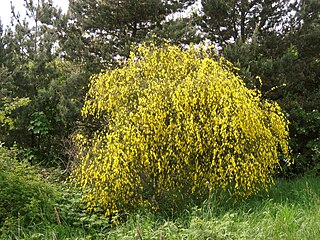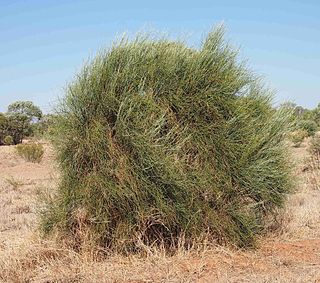
A broom is a cleaning tool consisting of usually stiff fibers attached to, and roughly parallel to, a cylindrical handle, the broomstick. It is thus a variety of brush with a long handle. It is commonly used in combination with a dustpan.

A shrub or bush is a small- to medium-sized woody plant. Unlike herbs, shrubs have persistent woody stems above the ground. They are distinguished from trees by their multiple stems and shorter height, and are usually under 6 m (20 ft) tall. Plants of many species may grow either into shrubs or trees, depending on their growing conditions. Small, low shrubs, generally less than 2 m (6.6 ft) tall, such as lavender, periwinkle and most small garden varieties of rose, are often termed "subshrubs".

Cytisus scoparius, the common broom or Scotch broom, syn. Sarothamnus scoparius, is a perennial leguminous shrub native to western and central Europe. In Britain and Ireland, the standard name is broom, but this name is also used for other members of the Genisteae tribe, such as French broom or Spanish broom, and the term common broom is sometimes used for clarification. In other English-speaking countries, the most prevalent common name is Scotch broom ; It is known as English broom in Australia.

Eremophila is a genus of more than 260 species of plants in the figwort family, Scrophulariaceae all of which are endemic to mainland Australia.. Eremophilas are widespread in the arid areas of Australia, especially Western Australia and range in size from low-growing shrubs to small trees. The petals are joined, at least at their bases, into a tube with the upper petals different in size and shape from the lower ones. Some species have common names including emu bush, poverty bush or fuchsia bush, reflecting the belief that emus eat the fruit, their arid environment or a superficial resemblance to the flowers of plants in the genus Fuchsia.

Baccharis is a genus of perennials and shrubs in the aster family (Asteraceae). They are commonly known as baccharises but sometimes referred to as "brooms", because many members have small thin leaves resembling the true brooms. They are not at all related to these however, but belong to an entirely different lineage of eudicots. B. halimifolia is commonly known as "groundsel bush", however true groundsels are found in the genus Senecio.

Ruscus is a genus of six species of flowering plants, native to western and southern Europe, Macaronesia, northwest Africa, and southwestern Asia east to the Caucasus. In the APG III classification system, it is placed in the family Asparagaceae, subfamily Nolinoideae. Like many lilioid monocots, it was formerly classified in the family Liliaceae.

The broom hare is a species of hare endemic to northern Spain. It is restricted to the Cantabrian Mountains in northern Spain between the Serra dos Ancares and the Sierra de Peña Labra. This region is about 230 km (140 mi) from east to west and 25–40 km (16–25 mi) from north to south. It lives in mountains at elevations up to 2,000 m (6,600 ft), though it descends during the winter to avoid the colder temperatures and snow. Its preferred habitat is heathland, containing mainly Erica, Calluna, and Vaccinium, with much shrub cover of Cytisus, Genista, and Juniperus. It also inhabits clearings in mixed deciduous forests of oak and beech.

Purple sage has various uses, mostly referring to plants.

Baccharis pilularis, called coyote brush, chaparral broom, and bush baccharis, is a shrub in the daisy family native to California, Oregon, Washington, and Baja California. There are reports of isolated populations in New Mexico, most likely introduced.

The dwarf wych elm cultivar Ulmus glabra 'Nana', a very slow growing shrub that with time forms a small tree, is of unknown origin. It was listed in the Simon-Louis 1869 catalogue as Ulmus montana nana. Henry (1913), referring his readers to an account of the Kew specimen in the journal Woods and Forests, 1884, suggested that it may have originated from a witch's broom. It is usually classified as a form of Ulmus glabra and is known widely as the 'Dwarf Wych Elm'. However, the ancestry of 'Nana' has been disputed in more recent years, Melville considering the specimen once grown at Kew to have been a cultivar of Ulmus × hollandica.

Eremophila scoparia, commonly known as silver emubush, is a flowering plant in the figwort family, Scrophulariaceae and is endemic to Australia. It is a broom-like shrub with narrow, hooked leaves, small sepals and deep lilac-coloured to white petals and is common and widespread in southern parts of the continent.

Psoralea pinnata is an erect evergreen shrub or small tree that grows to a height of 1.5 metres (5 ft) to 4 metres (13 ft) tall.

Psorothamnus is a genus of plants in the legume family. These are shrubs and small trees. Many are known by the general common name indigo bush. Some are referred to as daleas, as this genus was once included in genus Dalea. These are generally thorny, thickly branched, strongly scented bushes. Most species bear lupinlike raceme inflorescences of bright purple legume flowers and gland-rich pods. Psorothamnus species are native to the southwestern United States and northern Mexico. The genus is paraphyletic and it has been proposed that the genus Psorodendron be reinstated to accommodate sections Xylodalea, Capnodendron, and Winnemucca.

Baccharis sarothroides is a North American species of flowering shrub known by the common names broom baccharis, desertbroom, greasewood, rosin-bush and groundsel in English and "escoba amarga" or "romerillo" in Spanish. This is a spreading, woody shrub usually sticky with glandular secretions along the primarily leafless green stems. The small, thick leaves are a few centimeters long and are absent much of the year, giving the shrub a spindly, twiggy appearance. It flowers abundantly with tiny green blooms on separate male and female plants.

Cytisus striatus is a species of flowering plant in the legume family known by the common names hairy-fruited broom, Portuguese broom, French broom and Spanish broom. This plant is native to the Iberian Peninsula.
"Broom of the Cowdenknowes", also known as "Bonny May", is a traditional Scottish love ballad, Child #217. It has been traced to the seventeenth century, but its exact origin is unknown.

Apophyllum is a genus of plant native to Australia. It contains only one species, which by definition makes the genus a monotypic genus. This single species is called Apophyllum anomalum, commonly called warrior bush or broom bush.

Broom Hill, sometimes spelt Broomhill, is a small area of Orpington, England, located just to the west of Orpington High Street. It takes its name from a shrub located on the hill that was used to make brooms. Originally a rural locality it was progressively built over with housing during the course of the 20th century.

Genisteae is a tribe of trees, shrubs and herbaceous plants in the subfamily Faboideae of the legume family Fabaceae. It includes a number of well-known plants including broom, lupine (lupin), gorse and laburnum.

Ayvat Bendi Nature Park is a nature park located in Eyüp district of Istanbul Province, Turkey.



















